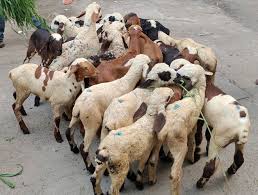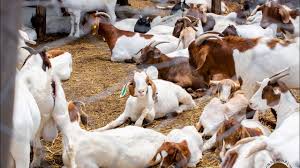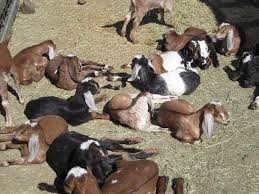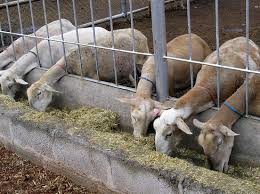Fattening/Finishing involves the intensive feeding of sheep and goats to achieve slaughter weight with adequate fat deposits in feedlots. This process targets the local market, which has a high demand for fattened animals.
The operation of large feedlots by export slaughterhouses and independent feedlot operators (on-farm feedlots) is becoming increasingly feasible.
The principal functions of such feedlot operations are to assemble large numbers of sheep and goats, often from different genetic and management backgrounds, and produce a product of acceptable standard.
The following guidelines serve both large operations and small farmers seeking to fatten smaller numbers of sheep and goats. This technical bulletin focuses on these practices.
Read Also: Diseases Fishes can get from Feeds
Advantages of Fattening

Fattening is a strategic feeding option that offers several advantages under Ethiopian conditions:
1. Technically simple and within the capabilities of small farmers, with highly visible results.
2. Benefits are realized within a short period, unlike other animal production activities.
3. Generates cash income that is highly desirable among farmers.
4. Generally profitable, as the value per kilogram of live weight increases as both weight and condition improve.
Fattening Systems for Sheep and Goats
Intensive feeding before slaughter can be categorized into two systems:
1. Traditional Systems: This system generally depends on grazing natural or planted pastures with variable degrees of supplementation. Animals require a longer period to attain market weight and condition, with significant fluctuations depending on feed availability. This system can be improved to supply animals of acceptable condition to slaughterhouses for export.
2. Agro-Industrial Byproduct-Based Fattening: This system utilizes agro-industrial byproducts for feeding sheep. It is practiced globally and can be promoted in areas with access to these byproducts, such as sugar processing byproducts, molasses, and corn.
Protein sources like oilseed cakes can be sourced from nearby processing plants, and brewery byproducts can also be used.
Guidelines for Fattening Sheep and Goats
When selecting animals for intensive fattening, consider the following factors:
1. Condition: Choose healthy animals without visible physical defects. Select animals with medium body condition (scores of 2.25–3.0).
2. Skeletal Frame: Select animals with a large skeletal frame and good body condition.
3. Castration: Castration can influence the fattening process.
4. Breed: Identify breeds with the greatest potential for growth and fattening.
5. Sex: Females mature earlier than males, and males may cause problems in feedlots due to fighting.
6. Weight: The starting weight influences the duration of feeding and feedstuffs required. Lighter animals require more roughage, while heavier animals require more concentrates and a shorter feeding period.
7. Age: It is advisable to select animals between 2 and 4 years of age for fattening. Ensure teeth are sound for proper feed utilization.
Management of Finishing Sheep and Goats

A successful fattening program begins with securing the necessary feed supplies. Underfeeding and incorrect timing are common causes of failure.
Minimizing movement is essential during the fattening period, as the goal is to convert as much feed as possible to body tissue. The first two weeks after arrival are critical, as animals may be stressed, hungry, and thirsty from long-distance travel.
1. Rest animals for a few hours in a dry, clean, sheltered area with access to fresh water upon arrival. Then, offer grass or mixed grass-legume hay.
2. Provide salt during the first two weeks; thereafter, trace mineral salt can be added to the complete diet.
3. Ensure feed is available at all times, adjusting supply if no feed remains in the morning.
4. Gradually adjust animals to the fattening concentrate diet over two weeks, increasing concentrate intake every two days while providing roughage.
5. Sort animals by weight, size, or sex and feed them in uniform groups to prevent larger animals from bullying smaller ones.
6. Cull non-performing animals early to maximize the efficiency of the operation.
Housing and Shelter Requirements
Sheep and goats should have access to shelters that protect them from adverse environmental conditions. These shelters can be constructed from locally available materials such as bamboo or mud, with a thatched roof.
The space required is about 2 square meters per animal, with open walls on one side to provide ventilation without drafts. Muddy feedlots drastically reduce feed efficiency, so keeping the premises dry is essential. Feeding racks should be accessible to both animals and caretakers.
Read Also: Diseases Fishes can get from Feeds
Socio-Economic Considerations

Animals for fattening should be purchased when prices are low and sold at times of peak demand. Feeds should also be bought during low-price periods and stored, increasing the profit margin of the operation.
Health Management in Fattening Operations
Using owned animals for fattening is preferable, with purchases from nearby villages as a second option. Purchase from local markets should be the last resort due to the high incidence of diseases such as pestes des petits ruminants (PPR) when animals from different sources are gathered. Treat animals for internal and external parasites before starting the feeding operation.
Feeding Systems for Finishing Sheep and Goats
Finishing can be achieved with rations that vary in roughage and concentrate proportions. Higher concentrate levels shorten the fattening period.
1. Concentrates: Grains, molasses, and high-protein feeds like oilseed cakes provide dietary energy.
2. Roughages: Roughages can vary, with the amount fed depending on the objective of fattening.
Fattening Ration Types
1. Starter Ration: Contains higher roughage and 14% crude protein. Typically fed for one week, or two weeks for animals transported over long distances.
2. Intermediate Ration: Gradually decreases roughage and contains 13% crude protein. Fed for one week.
3. Finishing Ration: Contains minimal roughage and gradually decreases protein content from 13% to 12%. Heavy lambs require more concentrate, while lighter lambs can be fed more roughage.






